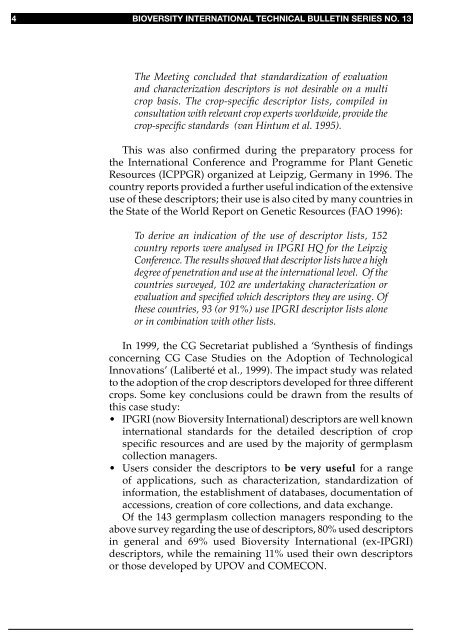Developing crop descriptor lists - Bioversity International
Developing crop descriptor lists - Bioversity International
Developing crop descriptor lists - Bioversity International
You also want an ePaper? Increase the reach of your titles
YUMPU automatically turns print PDFs into web optimized ePapers that Google loves.
4 BIOVERSITY INTERNATIONAL TECHNICAL BULLETIN SERIES NO. 13<br />
The Meeting concluded that standardization of evaluation<br />
and characterization <strong>descriptor</strong>s is not desirable on a multi<br />
<strong>crop</strong> basis. The <strong>crop</strong>-specific <strong>descriptor</strong> <strong>lists</strong>, compiled in<br />
consultation with relevant <strong>crop</strong> experts worldwide, provide the<br />
<strong>crop</strong>-specific standards (van Hintum et al. 1995).<br />
This was also confirmed during the preparatory process for<br />
the <strong>International</strong> Conference and Programme for Plant Genetic<br />
Resources (ICPPGR) organized at Leipzig, Germany in 1996. The<br />
country reports provided a further useful indication of the extensive<br />
use of these <strong>descriptor</strong>s; their use is also cited by many countries in<br />
the State of the World Report on Genetic Resources (FAO 1996):<br />
To derive an indication of the use of <strong>descriptor</strong> <strong>lists</strong>, 152<br />
country reports were analysed in IPGRI HQ for the Leipzig<br />
Conference. The results showed that <strong>descriptor</strong> <strong>lists</strong> have a high<br />
degree of penetration and use at the international level. Of the<br />
countries surveyed, 102 are undertaking characterization or<br />
evaluation and specified which <strong>descriptor</strong>s they are using. Of<br />
these countries, 93 (or 91%) use IPGRI <strong>descriptor</strong> <strong>lists</strong> alone<br />
or in combination with other <strong>lists</strong>.<br />
In 1999, the CG Secretariat published a ‘Synthesis of findings<br />
concerning CG Case Studies on the Adoption of Technological<br />
Innovations’ (Laliberté et al., 1999). The impact study was related<br />
to the adoption of the <strong>crop</strong> <strong>descriptor</strong>s developed for three different<br />
<strong>crop</strong>s. Some key conclusions could be drawn from the results of<br />
this case study:<br />
• IPGRI (now <strong>Bioversity</strong> <strong>International</strong>) <strong>descriptor</strong>s are well known<br />
international standards for the detailed description of <strong>crop</strong><br />
specific resources and are used by the majority of germplasm<br />
collection managers.<br />
• Users consider the <strong>descriptor</strong>s to be very useful for a range<br />
of applications, such as characterization, standardization of<br />
information, the establishment of databases, documentation of<br />
accessions, creation of core collections, and data exchange.<br />
Of the 143 germplasm collection managers responding to the<br />
above survey regarding the use of <strong>descriptor</strong>s, 80% used <strong>descriptor</strong>s<br />
in general and 69% used <strong>Bioversity</strong> <strong>International</strong> (ex-IPGRI)<br />
<strong>descriptor</strong>s, while the remaining 11% used their own <strong>descriptor</strong>s<br />
or those developed by UPOV and COMECON.

















